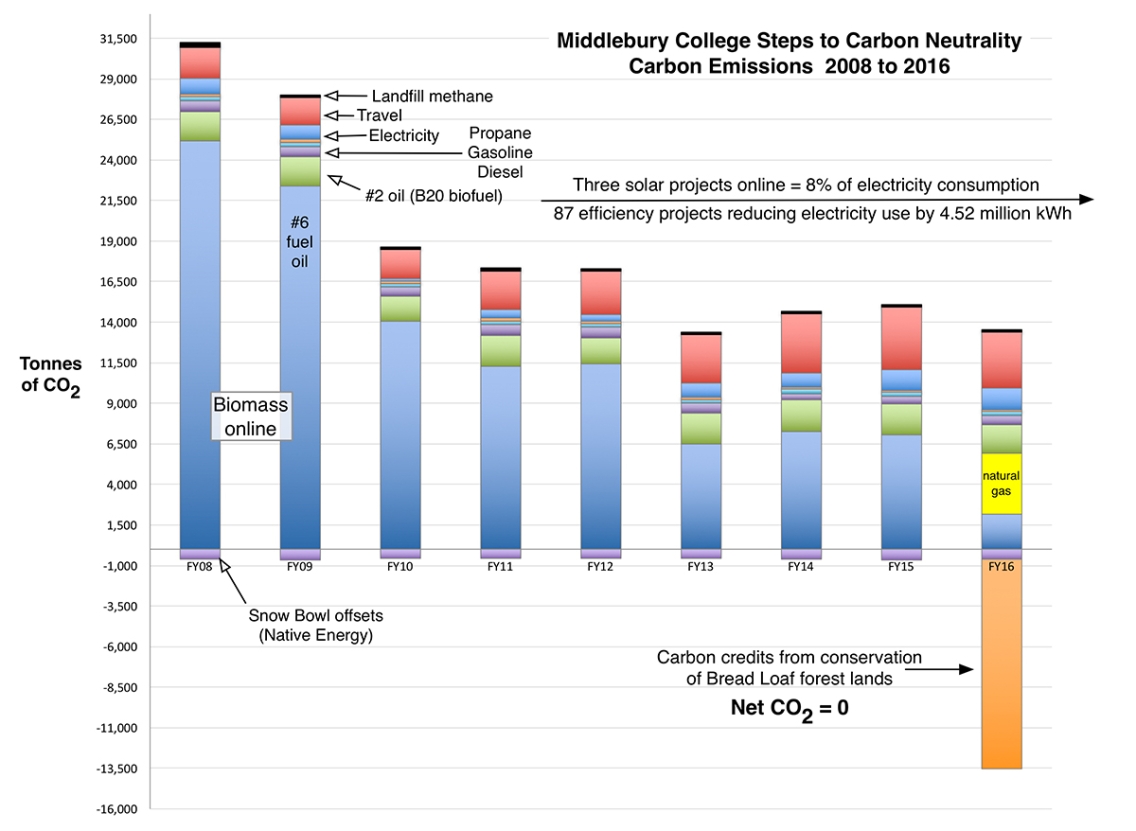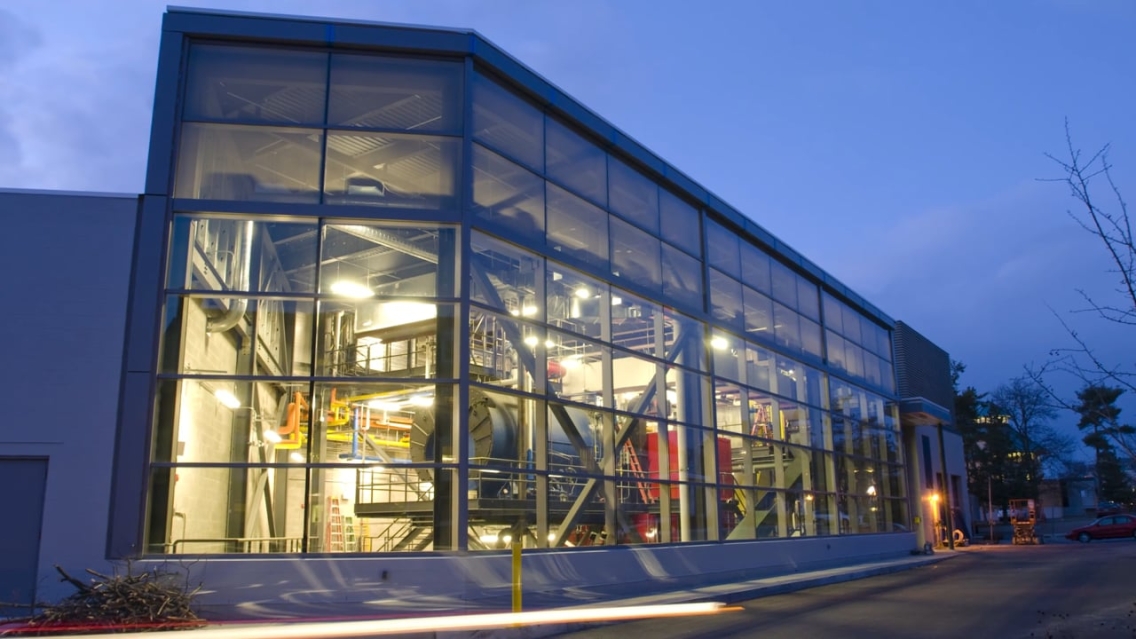Middlebury Reaches 2016 Carbon Neutrality Goal
MIDDLEBURY, Vt. – Middlebury announced today that it has reached carbon neutrality—a major sustainability milestone many years in the making. In doing so, Middlebury attains a net-zero carbon footprint, meaning that the institution has balanced the amount of carbon emissions it releases with an equivalent amount sequestered or offset.
“I am thrilled to announce this significant moment in Middlebury’s history of environmental leadership,” said President Laurie Patton. “I encourage the campus community to pause and reflect on the importance of this achievement and recognize the visionary work of so many people who brought us to this point.”
The quest for carbon neutrality began in 2001 when Middlebury completed its “Environmental Peak Report,” following a year of strategic planning. One of the report’s eight priorities was a recommendation that Middlebury set a carbon neutrality goal. That same year, a student intern conducted Middlebury’s first-ever emissions inventory in conjunction with the organization Clean Air – Cool Planet, laying the foundation for measuring carbon emissions on campus.

Middlebury’s steps to carbon neutrality.
(Click graphic to enlarge.)
By 2002, Middlebury’s Environmental Council had mapped out its first Carbon Reduction Initiative (CRI), setting in motion a multiyear data-collecting and planning process by students, staff, faculty, and administrators. The CRI working group recommended what it felt was an achievable goal of reducing greenhouse gas emissions by 8 percent below 1990 levels by 2012.
When it became clear that the first goal was reachable—thanks to trustee approval of a new biomass gasification plant—a group of students sought a more ambitious goal of reaching carbon neutrality by 2016. They brought their proposal to then-president Ron Liebowitz in 2006.
“Ron was impressed enough with the students’ arguments,” recalled Jack Byrne, director of sustainability integration, “that he said, ‘I’ll give you 20 minutes at the next trustees’ meeting. You better be prepared!’”
Liebowitz, who championed the carbon neutrality cause while demanding intellectual rigor from students, said he’s incredibly proud that Middlebury met a goal that, early on, sometimes felt like “a shot in the dark”—and that the achievement speaks to both the enthusiasm of students and the receptiveness of administrators and trustees to chase a lofty goal.
“The bigger lesson as educators is to give students the chance to pursue a big idea,” said Liebowitz, who is now president of Brandeis University.
In 2007, the trustees adopted a resolution for Middlebury to become carbon neutral by 2016.
“The path to carbon neutrality created new opportunities for learning and research at the College, and students have been involved at every step of the way,” said Nan Jenks-Jay, dean of environmental affairs. “The process of meeting this challenge created a community ethos of collaboration and ingenuity that is at the heart of what we do as an institution deeply invested in environmental education.”
May Boeve ’06.5 was one of several students closely involved with the push for carbon neutrality. “Middlebury students were part of a global wave of campus climate activism, and we knew that calling on our college to take up a bold demand could inspire action elsewhere,” said Boeve, now executive director of the leading climate activism organization 350.org. “The College showed admirable leadership at that time, and being heard by decision-makers helped transform us into lifelong activists and leaders.”
Technical innovation played a crucial role on the road to carbon neutrality. The first, and biggest, step forward came with the construction of the College’s groundbreaking biomass facility in 2008. The plant was the first of its kind—serial number 001, as Director of Facilities Services Mike Moser puts it. It allowed the College to radically reduce the two million gallons of No. 6 fuel oil burned annually.
The biomass plant was designed to replace half of that fuel. Now Middlebury has cut its No. 6 fuel oil consumption down from two million gallons to 600,000 gallons. Instead, some 24,000 tons of locally sourced wood chips come through the biomass plant each year. Middlebury’s biomass is considered carbon neutral because the forests that supply it are growing faster than what’s harvested, thereby absorbing more carbon than what’s emitted by burning wood chips.
Byrne and Moser emphasize the importance of verifying that the wood supply is truly sustainable. “We have to test the assumption [that it’s carbon neutral] all the time,” said Moser—which means, in some cases, relying on students to crunch the numbers, step out into the woods, and work side by side with local foresters.
Today the biomass gasification plant exceeds the manufacturer’s original specifications, saving the College between $1 and $2 million a year, while pumping $1 million into the local forest economy.
But, as with most entrepreneurial ventures, the path to neutrality was sometimes messy, sometimes disappointing. In 2007, for example, Middlebury partnered with the State University of New York College of Environmental Science and Forestry on a pilot project to grow willow shrubs on campus property as a potential local, renewable fuel source for the biomass plant. Unfortunately, after three years of growth, the initial harvest of willow chips contained too much moisture and then failed to gasify properly during a 2011 test at the biomass plant.
Biomass has played a key role in achieving carbon neutrality, but dozens of smaller initiatives have also made an impact. Over the last 14 years, Middlebury has completed 87 projects with Efficiency Vermont, investing roughly $1.5 million. As a result, Middlebury now saves $636,000—and 4.52 million kilowatt hours—annually.
Middlebury is also a partner in three solar projects that produce (or will produce, in the case of a final project coming online before the end of the year) roughly 8 percent of the campus’s total electricity load.
The final step came in the form of a landmark deal to conserve in perpetuity 2,100 acres of forestland on Middlebury’s Bread Loaf Mountain campus in Ripton, Vermont. By conserving the Bread Loaf lands, Middlebury can count the carbon sequestration of the preserved forest toward its carbon reduction efforts, rather than purchasing credits elsewhere.
“We’ve always cherished this magnificent place and now it will always sequester carbon, do all the other important things forests do,” said Jenks-Jay. “It will inspire us to find new ways to balance nature and human aspirations.”
For Middlebury administrators and students, meeting the carbon neutrality goal is a milestone, but not an end point. Having snatched the low-hanging fruit with existing efficiency upgrades, Moser said his team will continue to look for places to save energy. Middlebury is also continuing to investigate participation in a project to build a facility that would turn cow manure and other organic fuel into renewable natural gas, a step that could further cut back the use of fuel oil and compressed natural gas on campus.
“Middlebury will continue to improve its systems, seek new technologies, create educational opportunities, and set new sustainability goals,” said Jenks-Jay. “Now more than ever, we need a greater commitment to creating clean, zero-carbon energy systems in this country, and that responsibility and innovation will likely come within our cities, businesses, and colleges and universities.”


